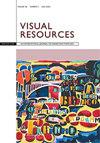Cultural Resistance in Henri Matisse’s Poèmes de Charles d’Orléans
IF 0.1
0 ART
引用次数: 0
Abstract
Henri Matisse (1869–1954) adopted medievalism, a motif of cultural resistance in Occupied France, as a symbol of national unity through his appropriation of the fifteenth-century poems of Charles de Valois, duc d’Orléans (1394–1465). Matisse saw parallels between the plight of the medieval poet, held captive in England, and his own circumstances in France during the Second World War. Begun in 1942, while recovering from his near-fatal illness, aided by his friend André Rouveyre (1879–1962), encouraged by the fugitive poet Louis Aragon (1897–1982), Matisse introduced covert symbols and coded messages of hope and rebirth into his book to highlight his nation’s heritage as he silently participated in the cultural battle that was being fought in France. This article analyses the aesthetic evolution of his wartime illustrated book Poèmes de Charles d’Orléans (1950), and examines his choice of poems, the handwritten text, his decorative illuminations, the images, d’Orléans’s portrait and the frontispiece within the context of the disruption to the French nation and his own personal circumstances.亨利·马蒂斯的诗中的文化抵抗,查尔斯·德奥尔良
亨利·马蒂斯(1869–1954)采用中世纪主义,这是被占领法国文化抵抗的主题,通过他对十五世纪奥尔良公爵查尔斯·德瓦卢瓦(1394–1465)诗歌的挪用,将其作为民族团结的象征。马蒂斯看到了这位被囚禁在英国的中世纪诗人的困境与第二次世界大战期间他在法国的处境之间的相似之处。始于1942年,在他的朋友安德烈·鲁维尔(1879–1962)的帮助下,在逃亡诗人路易斯·阿拉贡(1897–1982)的鼓励下,马蒂斯从近乎致命的疾病中康复,他在书中引入了希望和重生的秘密符号和编码信息,以突出他的国家遗产,因为他默默地参与了法国正在进行的文化斗争。本文分析了他的战时插图书《巴黎人》(Poèmes de Charles d'Orléans,1950)的美学演变,并在法国国家和他自己的个人环境受到破坏的背景下,考察了他对诗歌、手写文本、装饰性装饰、图像、d'Oréans的肖像和正面作品的选择。
本文章由计算机程序翻译,如有差异,请以英文原文为准。
求助全文
约1分钟内获得全文
求助全文

 求助内容:
求助内容: 应助结果提醒方式:
应助结果提醒方式:


